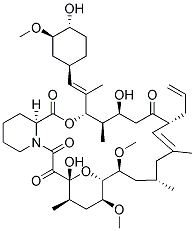All AbMole products are for research use only, cannot be used for human consumption.

FK-506 (also Tacrolimus or fujimycin) is a potent calcineurin (protein phosphatase 2B) inhibitor that requires FK 506-binding protein 12 (FKBP12) for activity (IC50 = 3 nM). FK-506 inhibits secretion of IL-1, IL-2 (IC50 = 1 nM), IL-3, IL-4, IL-6 (IC50 = 35 nM), GM-CSF, TNFα (IC50 = 10 nM), IFNγ and Myc from activated T-cells in vitro. FK-506 exhibits potent immunosuppressive, neuroprotective and anticonvulsant activity in vivo. The physiological effects of FK-506 also include regulation of nitric oxide neurotoxicity, neurotransmitter release, and regulation of Ca2+ release via the ryanodine and inositol-(1,4,5)-trisphosphate (IP3) receptors. Furthermore, it has become clear that, predominantly as a result of CaN inhibition, FK506 alters multiple biochemical processes in a variety of cells besides lymphocytes. FK506 and ascomycin inhibit signaling pathways in astrocytes and change the pattern of cytokine and neurotrophin gene expression.
*The compound is unstable in solutions, freshly prepared is recommended

Neural Plast. 2022 Feb 7;2022:2900875.
Presynaptic NMDA Receptors Influence Ca2+ Dynamics by Interacting with Voltage-Dependent Calcium Channels during the Induction of Long-Term Depression
Tacrolimus (FK506) purchased from AbMole

BMC Biol. 2021 May 20;19(1):108.
Very long intergenic non-coding (vlinc) RNAs directly regulate multiple genes in cis and trans
Tacrolimus (FK506) purchased from AbMole
_J-Neurosci_2015-Jan-7.jpg)
J Neurosci. 2015 Jan 7;35(1):64-73.
Sleep slow wave-related homo and heterosynaptic LTD of intrathalamic GABAAergic synapses: involvement of T-type Ca2+ channels and metabotropic glutamate receptors.
Tacrolimus (FK506) purchased from AbMole
| Cell Experiment | |
|---|---|
| Cell lines | PMoH |
| Preparation method | PMoH (2.5 x 105 cells/well) were seeded in 12-well plates and treated with various concentrations of the immunosuppressants. At 24, 48 and 72 hr post-treatment, wells were washed twice with sterile PBS and cells were fixed and stained with 0.1% crystal violet in 1M citric acid containing 20% methanol for 20 minutes at room temperature. Wells were washed thoroughly with sterile PBS to remove excess crystal violet and then air-dried. Bound dye was solubilized with 100 μl 100% DMSO for 20 minutes and the absorbance of the supernatants was measured at 544 nm using the FluoStar Optima (BMG LabTech) plate reader. |
| Concentrations | 0.005 µg/ml |
| Incubation time | 24, 48, 72 h |
| Animal Experiment | |
|---|---|
| Animal models | BDF1 mice |
| Formulation | Solubilized in DMSO and diluted with PBS containing 10% dimethylacetamide (Sigma-Aldrich) and 6% Solutol (Sigma-Aldrich). |
| Dosages | twice daily at 3.2, 10, 32 or 100 mg/kg for 5 days |
| Administration | oral gavage |
| Molecular Weight | 804.02 |
| Formula | C44H69NO12 |
| CAS Number | 104987-11-3 |
| Solubility (25°C) | DMSO 90 mg/mL Ethanol 80 mg/mL |
| Storage | 2-8°C, protect from light |
[4] Dumont FJ. Curr Med Chem. FK506, an immunosuppressant targeting calcineurin function.
| Related Autophagy Products |
|---|
| Vacuolin-1
Vacuolin-1 is a cell-permeable inhibitor of Ca2+ dependent fusion of lysosomes to the cell membrane. Vacuolin-1 blocks the Ca2+-dependent exocytosis of lysosomes and prevents the release of lysosomal content without affecting the process of resealing. vacuolin‐1 is a potent and selective PIKfyve inhibitor and inhibits late‐stage autophagy by impairing lysosomal maturation. |
| CA77.1
CA77.1 is a potent, brain-penetrant and orally active chaperone-mediated autophagy (CMA) activator with favorable pharmacokinetics. |
| KAN0438757
KAN0438757 is a potent and selective inhibitor of the metabolic kinase PFKFB3 with an IC50 of 0.19 μM. |
| Metofenazate
Metofenazate is a selective calmodulin inhibitor. |
| Patulin
Patulin (Terinin) is a mycotoxin produced by a variety of fungi, causes chromosome breakage, mutation, teratogenic and cytotoxic. Patulin induces autophagy-dependent apoptosis through lysosomal-mitochondrial axis, and causes DNA damage. |
All AbMole products are for research use only, cannot be used for human consumption or veterinary use. We do not provide products or services to individuals. Please comply with the intended use and do not use AbMole products for any other purpose.


Products are for research use only. Not for human use. We do not sell to patients.
© Copyright 2010-2024 AbMole BioScience. All Rights Reserved.
